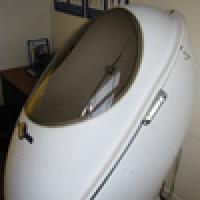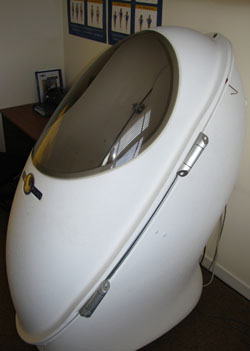
Fat body slim

The Bod Pod.
Researchers are working to understand the effect that dietary interventions have on body composition and biological parameters of cardiovascular risk, and how molecules produced by fat tissue influence cancer development. "Knowing how a person's fat distribution and quantity influence the development of these diseases and how dietary interventions can affect weight and cardiovascular risk is essential to prevent a global epidemic of obesity-related disease", says Dr Giovanna Bermano from the Institute for Health and Welfare Research and the Centre for Obesity Research and Epidemiology (CORE), Robert Gordon University.
Bermano and her team are behind one of the exhibits at this year's Royal Society Science Summer Exhibition. Part of their exhibit is the Bodpod, which allows visitors to step inside and have their body composition measured.
To determine our body composition, we need to know how much of our bodies are made up of fat, and how much is other fat-free tissues such as muscle and bone. Luckily, measuring this doesn't require any medical procedures — all you need to know is how dense you are.
'The Bod Pod measures how much air your body displaces to find your volume (similar to the way the water rises when you hop into the bath) and uses an electronic scale to measure your weight. It uses these values to calculate the percentage of your body which is made up of fat. The equation $$\mbox{Density}=\frac{\mbox{Mass}}{\mbox{Volume}}$$ calculates the overall density, $D_{body},$ of your body. Your body's total volume, $V$, is made up of fat and fat-free tissue: $$V_{body} = V_{fat} + V_{fat-free}$$ which can be rewritten in terms of mass, $M$, and density, $D$, using the density equation: $$\frac{M_{body}}{D_{body}} = \frac{M_{fat}}{D_{fat}} + \frac{M_{fat-free}}{D_{fat-free}}.$$ The density of the fat, $D_{fat}$, in our bodies is very different from the density of the other fat-free tissues, $D_{fat-free}$, because muscles and bones are heavier than fat. Dividing both sides of the last equation by your total mass, $M_{body}$, gives $$\frac{1}{D_{body}}=\frac{F}{D_{fat}}+\frac{1-F}{D_{fat-free}},$$ where $F=M_{fat}/M_{body}$ is the proportion of your body mass that is made up of fat. This equation can be rearranged to give: $$F=\frac{A}{D_{body}}-B,$$ where the values $A$ and $B$ depend only on the densities of fat and fat-free tissue. The Bod Pod uses this equation to calculate your percentage body fat which is simply $F \times 100.$ It uses estimates of $A$ and $B$ from past experimental research. For the general population $A = 4.95$ and $B = 4.5$ are used, but these values can vary according to your age, gender or race.
This article is based on the Maths Inside project, a collaboration of Plus and the Mathematics Promotion Unit (run by the London Mathematical Society and the Institute of Mathematics and its Applications), in conjunction with the Fat body slim exhibit and the Royal Society. The Maths Inside project reveals the maths behind four specially chosen exhibits at the Royal Society Summer Science Exhibition. Click here to find out more about the project and to read articles accompanying other exhibits.